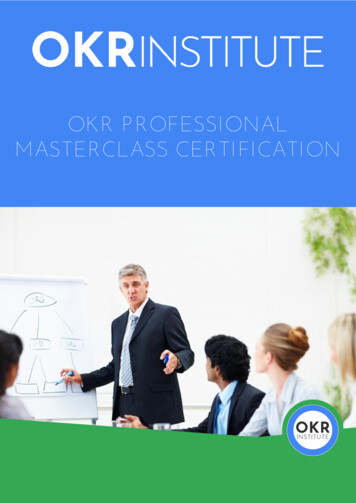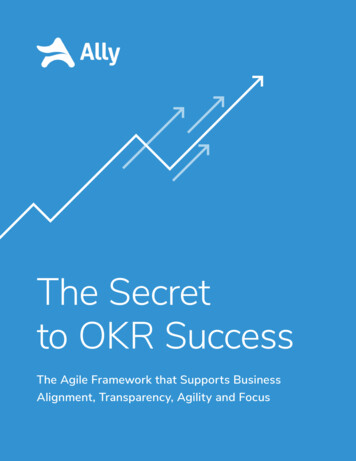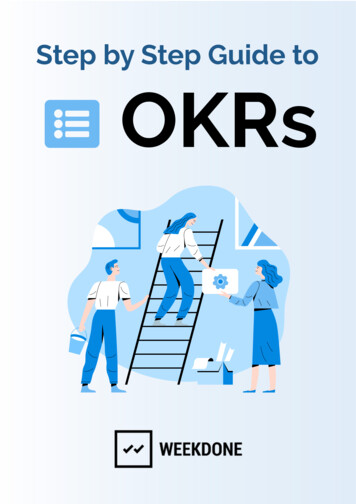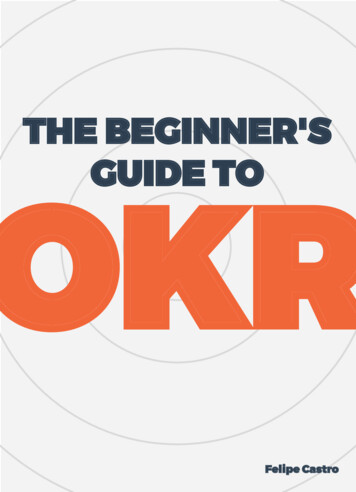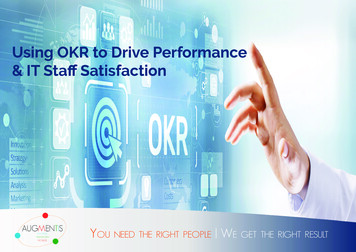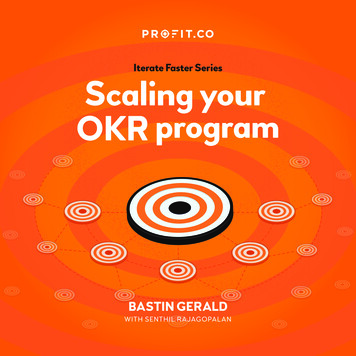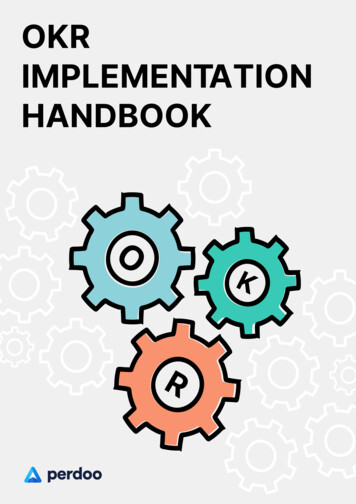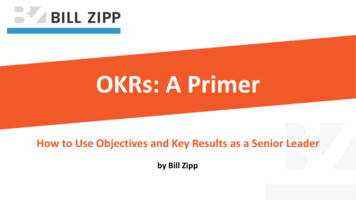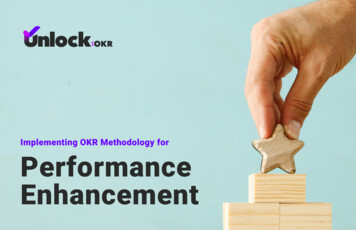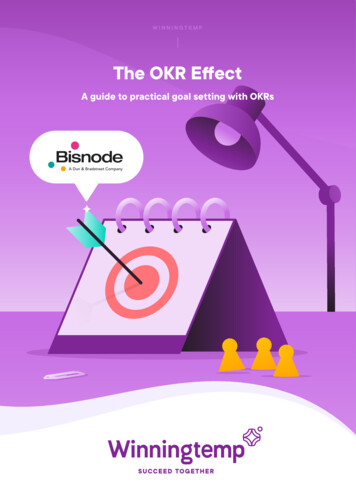
Transcription
WINNINGTEMPThe OKR EffectA guide to practical goal setting with OKRs
THE OKR EFFECT“OKRs are living,breathing organisms.”That’s it. That’s the unadulteratedessence of OKR in a nutshell.There’s no scarcity of educational materials andquick guides on OKR and how organisationsset goals using the framework, but no otherdefinition can capture the soul of OKR thanthese few well-chosen words penned downby the author of Measure What Matters andlegendary venture capitalist John Doerr.The OKR methodology has changed the courseof several well-known companies, most notablyGoogle. It took ninety minutes and a powerpointpresentation for John Doerr to convince their coreteam to start implementing OKR back in 1999. Thevisionaries in them recognised the value in it, theunderlying principles, and the more obvious practicality of the process. Fast forward to the present,Google’s management team credits a vital part oftheir outstanding success to OKR and the ideologiesit embodies.They were, indeed, the perfect match.However, blindly emulating Google’s OKRPlaybook and guidelines and silently hopingfor a resounding success won’t help you bring it tofruition.Several companies learned that the hard way.No two organisations are built on the samefoundation; they have different values, capabilities, missions, and visions. How they grow andscale depend on several factors that consequentlyaffect their capacity to implement OKR as theirgoal-setting methodology.To understand the art and science of OKR, andmost importantly, how it can be customised andadopted by companies that run on a different scalethan Google, we sat down with Cecilia WesterholmBeer from Bisnode for multiple knowledge-sharingsessions.At Bisnode, 2,100 experts work daily tointerpret, refine, and understand the data that formsbusiness decisions. Bisnode helps make day-to-daylife easier by delivering thousands of decisionmaking documents to companies, governmentagencies, municipalities, and organisationsevery day.Cecilia Westerholm Beer, CHRO at Bisnode,is an experienced HR Leader with vast experiencein transformation and change. In this e-book,she shares her honest and unbiased outlookon how OKR works, how challenging it isfor companies of all sizes to set the first goal, thehurdles they still have to overcome, and how tocontinue working with it to see the magic unfold.Moreover, she tosses in invaluable nuggetsof wisdom to help you get started withthe revolutionary goal-settingmethodology that is OKR.
THE OKR EFFECTOn OKRInspired by the ‘Father of OKR’ Andy Grove, JohnDoerr, in his book, talks at length about a goalsetting system that combines quantifiable progresswith human values.It paves the way for horizontal collaboration anddisciplined thinking, establishes harmony, spursinnovation, and drives the entire organisationtowards a common goal.His powerpoint presentation defined OKRs as“A management methodology that helps to ensure that the company focuses effortson the same important issues throughout the organisation.”OKR stands for Objectivesand Key Results.The objective is the direction. It defines what is it that the organisation must achieve.Your long-term objective should be closely associated with the vision and purposeof your organisation. This should be inspirational yet attainable.Once you’ve decided on the long-term objective, segment it into concreteorganisation-wide objectives with clear action plans.Now it’s your employees’ turn. They can set individual or group OKRs based on theorganisation-wide OKRs. Train your employees to not only set objectives that theymust achieve but also to set aspirational, audacious goals that enable them tounlock their creativity.
THE OKR EFFECTKey Result is the execution. These are the requirements that are needed to achieve the objective.These are number-bound, measurable, and verifiable. Completion of all the KRs indicatesthat the objective is achieved.A key result must be number-oriented, but it should also be backed by the qualityof the result. It evolves over time as the task progresses.Treat these as milestones that you need to cover to reach the objective. KRs shouldbe tough to complete, but again, these should be realistic.KRs provide the focus and accuracy that’s required to align your entire organisationand unite them to attain the objectives.Through coordination, planning, strong leadership, and transparent companyculture, OKRs reveal the path towards greatness and provide everyone with clarity and purpose.On a much more practical level, the framework promotes self-leadership, disciplined thinking, and teamcollaboration by removing unnecessary silos and increasing workplace satisfaction.
THE OKR EFFECTWhy Bisnode chose towork with OKRs“As an HR professional, I’ve always been curiousto know what motivates people to get up in themorning, put their feet on the ground, and beexcited about going to work. On the other hand,why is it that some people would rather stay athome under the cover on rainy mornings?”Her curiosity led her to study the works of authorssuch as Daniel Pink, who in his book Drive:The Surprising Truth About What Motivates Us,talks about two specific types of motivation extrinsic and intrinsic.As the names suggest, extrinsic motivation dependson external forces such as monetary benefits, praisefrom the supervisor, whereas intrinsic motivationdrives people from within. It can be the feeling ofeuphoria after a job well done, the sense ofcontentment when someone achieves their goal.“Both in theory and practice, I know that someonewho has clear goals will jump up in the morning(even before the alarm goes off!), go to work andfeel that what they’re doing is meaningful.If we look at growing startups - you have startups inthe basement with lousy working conditions. Theywork round the clock, but they still love their job.So, obviously, it’s not extrinsic factors such asfruit baskets or other fancy things that matter.When push comes to shove, it is about thatclarity of vision, and I believe, OKRs can givethat clarity.”Cecilia, and other modern HR professionals whobelieve in the agile way of working and drivingthe business forward, resort to OKRs to align theentire organisation with one common purpose- the business objectives that matter.It helps battle cynicism and demotivation byenabling the people to focus on the big picture.Employees feel personally accountable for theirjob and become motivated to contribute to theoverall goal of the organisation.
THE OKR EFFECTBisnode s OKR TemplateObjective – we will Key Result – asmeasured by DependencyObjective 1Key Result 1Key Result 2Key Result 3Other team/PersonObjective 2Key Result 1Key Result 2Key Result 3Other team/PersonObjective 3Key Result 1Key Result 2Key Result 3Other team/Person“Every company needs to interpret and adopt OKR differently.What worked for Google may not work for others, so it’s pointlessto try and copy how Google used OKRs, but rather drawinspiration from their way of thinking and customiseOKR to the needs of your company.”The Scandinavian touch“Working with OKRs and agile technology go handin hand with Scandinavian leadership.It obviously happens in the US, and that’s where itwas developed, but I think that one of the reasonswhy we are one of the early adopters is becauseconcepts such as self-leadership, takingresponsibility, setting your own goals is quiteclose to the Scandinavian culture.”“The beauty of OKR liesin the fact that it forcesus not to tell employeeswhat to do.”
THE OKR EFFECTOn getting executive buy-inThe most crucial step forwardPractising what you preach should be the mantrawhen it comes to OKR implementation. If the goalis to instil a sense of accountability in your teammembers for them to start taking OKRs seriously,you have to start by convincing the top lineleadership team. They must drive the projectforward and push people to set their OKRs.“It was super difficult to get everybody on board.One of the primary reasons why it was so difficultwas that we had already done a lousy implementation of something that was kind of like OKRbefore. So last year I decided that now we willstart working with OKR for real, and we’re going tochange the system.It’s not an easy feat to change the mindset of theentire organisation in one day, it’s a gradual processand the leaders should exhibit the behaviour for itto be reflected on the people. They have to set theirown OKRs and stick to them religiously.Slowly and surely, we got the managers on board.You need to be determined and your top-lineleadership team needs to be determined.Our CEO is completely on board, and he is deadset on getting OKR implemented.”This is something Cecilia struggled with in thebeginning, but thankfully, she got the support sheneeds from the rest of the leadership team.
THE OKR EFFECTOn people, culture, and capacityThe Bisnode cultural trinityAt Bisnode, Cecilia focuses on developing their cultural trinity: People, Culture, and Capacity.Cecilia believes that OKR has a huge effect on all three of these pillars.“The obvious effect can be seen in the ‘Capacity’ - OKRs ensure thateverybody in the organisation is aware of where the company is heading,and all of them contribute to its growth journey.We are incredibly transparent when it comes to company ‘Culture’.First of all, everyone can see each other’s goals. Second of all, in many companies,people feel like they can’t fail, which leads to the practice of sandbagging. But inBisnode, we encourage people to have goals that are aspirational, way more thanwhat is absolutely required. It doesn’t matter if they fail to achieve the goals inone shot; we celebrate their efforts. For us, it’s not just three words withoutheart and context - it’s culture for real.As far as ‘People’ is concerned, we actively promote self-leadership.We empower our people to set their own goals. They have to figure out how theirteam can connect themselves to the overall goals of the business.This way, we put a lot of burden on the employee because they are the ones whoknow what they require to perform better, not their managers.”
THE OKR EFFECTOn the OKR magicThe real values that Bisnode witnessedTransparent company cultureHelping where help is neededIf done right, OKRs help establish transparency inthe organisation which paves the way for ownership,collaborative teamwork, and camaraderie. At Bisnode,Cecilia and her team encourage people to taketheir own decisions and set their personal goalsby aligning those with the primary organisationalobjective.Since all the objectives are clearly visible, teamscan divert their attention to what demands themost attention. When a team struggles to achievetheir goals, other teams can pitch in andcontribute in any way they can.After all, with complete autonomy,comes great responsibility.“We can see that in the numbers that people getmore and more engaged with the passing time!Eventually, it solves the problem of attrition, aspeople want to stay longer and commit to thegoals that they set for themselves.”“One of the most significant things we had to dobefore implementing OKR is to convince people thatthey must understand the strategy. If they don’tunderstand the strategy, they can’t really set thegoals. We organise ‘Strategy Translation’ workshopswhere each team works on its individual strategyregarding what the goals mean for them and theentire organisation. That’s one of the biggestprocesses that we streamlined.”Decreased redundancyIn large organisations, it’s often challenging tokeep track of all the activities everyone hasundertaken. Sometimes it so happens that morethan one employees focus their efforts on aspecific task, thus increasing redundancy. With theOKR framework in place, it becomes easier for thecontributors to divide the responsibilities and workmore efficiently.Improved employee engagement“Goals that people set for themselvesand that are devoted to attainingmastery are usually healthy. But goalsimposed by others--sales targets,quarterly returns, standardised testscores, and so on--can sometimeshave dangerous side effects.”
THE OKR EFFECTOn fuzzy OKRsChallenges while setting goalsGetting rid of fuzzy goalsFuzzy goals are bound to create confusion amongpeople who are working hard to achieve somethingcompletely arbitrary.How do you measure your efforts when you don’thave a clear idea of the direction and the journeymilestones? To give clear instructions to thepeople, the leaders need to have a concrete planand measurable steps to achieve that. The hardestpart is, it’s a mindset more than anything else.Not only do your people have to set clearobjectives, but they also have to dare themselvesto quantify the steps they are taking to get closerto the goal. As explained succinctly by John Doerr,OKR is “a vaccine against fuzzy thinking andfuzzy execution”.“We constantly nag about how to set a goalthat’s measurable, both qualitatively andquantitatively. But, nagging is required to startchanging the mindset of the entire organisation.You need organisation-wide training to ensurethat everybody is on the same page. At Bisnode,we have an HR organisation that helps peoplewith their OKRs. It’s definitely a learning curve.If you’re just getting startedwith OKR, don’t focus too muchon fuzzy and clear goals in thefirst year. Let people set theirgoals; let them get used tothe system and then try toquantify the goals.”
THE OKR EFFECTDaring to be audaciousSetting only financial goals“People are afraid of setting aspirational goals. Theystill mentally connect it to monetary incentives.We are very clear on this aspect - there shouldn’tbe any direct connection to bonuses or incentives.Having said that, I think it’s in our DNA. We aretaught for so long that it’s nice to reach that100% mark, to get that medal. So, we do not dareto set those audacious goals. Naturally, peoplewant to over-achieve, so then they do not set thebar high enough.”“At traditional hierarchical companies like Bisnode,we struggle with the primary objective being afinancial one. For companies like ours, I suggestyou have one such financial goal, but dress itwith a couple of other qualitative, personal goals.It helps the employees feel comfortable. Striveto achieve the committed ones, but also writeaspirational goals to aim for more, to boostinnovation and change the way of thinking.”“The main challenge with having just financial goalsare you have to that transparent to measure it.Companies that are on the stock market can’treveal their financial status in real-time. Thenthere’s a delay in measuring results which affectthe entire organisation. I understand that’s ahardcore goal, but there should be other equallyimportant company growth objectives thatshould be measured.”“We need to solve this challengewith education and training. Do notunderestimate the amount oftraining it requires to write cleargoals. If you want to witness themagic of OKR, you have to repeateverything multiple times to getpeople on board.”
THE OKR EFFECTSetting Key Results“We let people decide their key results. We tell themto set both quantitative and qualitative key resultsthat will help them reach their objectives. I don’tbelieve in the cascading OKR format wheresomeone’s key results are being set as anobjective for somebody else - that doesn’tsolve the purpose. We encourage people tothink about innovative ways to achieve theirquantitative goals.”“If you are a Sales rep whohas to record X calls a day and book Ynumber of meetings, then think aboutwhat can you do differently to sell to theprospects, what new methods you shouldemploy. Maybe you should sit with CustomerSuccess, or get training to sell better. That’swhen the magic happens - when you start tothink about what you can do differentlyto reach the goals. That’s alsothe hardest er we will create a frictionfree everyday life for both ourcustomers and for each other.We will drive a superb Go ToMarket ‘machine’ in collaborationwith Sales and Marketing forcommercial success of scalableanalytics offeringsKey Results:10 improvements connected tofriction-free everyday lifeDecrease credit notes and increasecustomer satisfaction byimplementing NPS during Q3for category 1 customersIncrease Customer Satisfaction byfast handling of incoming customercases and by being best in class atclosing the loop, measured by NPSScale work with continuousimprovements by delivering 100improvements Q2Key Results:XX MSEK salesXX MSEK revenueCross-sales, marketing & analyticsmembers jointly develop, test,refine, and launch a new insightDevelop blueprint of deliveryprocess for scalable analyticscases and test for at least 3cases in Q1
THE OKR EFFECTThe magic numberHow many OKRs should you set for yourself andyour company?The ‘magic number’ can vary, depending on the sizeof the company and how ruthlessly you want yourOKRs to be. It takes practice to remove all the fuzzygoals and select the objectives and key resultsbased on priority and effectiveness.Cecilia suggests “as few as possible. On the highestlevel, we have four objectives now.Here’s what Bisnode’s OKR cycle looks like.Three of those are numbers-driven. I think thebiggest bottleneck is that people set too many.Irrespective of the size of your organisation,you must set 3 – 4 objectives with maximum3-4 KRs.”“The way we do it in Bisnode is that the companyobjectives are done annually and the key results onthe highest levels are broken down into quarterlygoals. However, eventually, we want people to setmore objectives and KRs each quarter or moreoften depending on their roles. That’s how agilewe want to be.”Setting OKRs1Set organisationalOKRsThe organisational objectivesdescribe the big picture, the top-levelfocus for the entire company. Theyare written and agreed upon by theleadership team.After this is done, all others can writetheir objectives in alignment with thecompany objectives and find howthey can contribute to it.2aUnit OKRsSetting the unit OKRs is an iterativeprocess. The management team ofeach unit conducts a workshop towrite a draft of the objectives andthen iterate before having it all inplace.Unit OKRs should define jointpriorities, not just a collection ofindividual OKR.If you have common Objectivesor Key results with other regions/functions – collaborate and connect.Unit OKRs could be a mix of annualand quarterly OKRs.2bTeam OKRs3Individual OKRsThe team objectives is an iterativeprocess as well – it can be done INPARALLEL with the unit OKRs andfollows the same pocess as theirs.Personal OKRs define what a teammember is working on. By the endof the OKR period, he/she can showwhat progress was made.Team OKRs should define teampriorities, not just a collection ofindividual OKRs.To define individual objectives, theperson involved discusses with his/her leader to know what is expected.It’s a dialogue with the leader andboth have to agree with the definedlist of objectives.Team OKRs could be a mix ofannual and quarterly OKRs.If you have common OKRs with otherteam members – collaborate andconnect. Individual OKRs could be amix of annual and quarterly OKRs.
THE OKR EFFECTOn hierarchy (or the lack of it)Top-down or bottom-up OKR?Top-down OKRs allow a baseline, a foundation forthe entire organisation to build upon. However, italso curbs engagement, flexibility and ends up beingone-dimensional. Even the slightest change in themiddle of the quarter has a domino effect thatdirectly affects the front-line contributors.“When you only have top-down goals, it directlyaffects the level of involvement, engagement, andthe sense of ownership of your employees.I can, for example, set the direction but it would bewrong for me to set the individual OKRs. If I do that,the key results will turn to KPIs. The best keyresults are actionable, and it’s very hard to havetop-down actionable key results.”Bottom-up OKRs gives the contributors the freedomto think strategically and choose most of their OKRs.However, relying on people to make the right choicesrequires immense control and careful consideration.The best way to approach this dilemma is to havea mix of top-down and bottom-up OKR to hit theright balance.Employees can decide how they can contribute to the top-down OKRs andbook some time for their passion projects.They become more involved in the projects and do not hesitate to share theirthoughts and ideas.It also promotes cross-functional collaboration as the teams can see each other’s OKRsand decide to link some of their objectives or key results to improve the existing process.Especially for remote employees, this process can do wonders as it aligns allthe teams with the primary objective and clears the way for horizontal linkage.“Combining top-downand bottom-up also means thatyou have a follow up a lot to ensurethat their OKRs align with the overallcompany OKRs. To achieve that, youshould have a dedicated personwhose responsibility will be to align allthe OKRs. That, of course, depends onthe size of the organisation and howyou are doing financially.”“It should definitely be a mix of both.I would recommend to my fellow traditionalcompanies to dare to set more bottom-up OKRs.Your employees know more about their capabilitiesand ambitions than the managers, so naturally,it should be their decision.”
THE OKR EFFECTTeam CollaborationRemoving hierarchy from the equation solves oneof the biggest challenges of cross-functional teamalignment.However, like everything else, it also depends onyour employees’ preferences and the choices theymake for themselves.Since the employees are free to link to others’OKRs, they tend to think more critically, take theobjectives as personal challenges, and strive toachieve those to the best of their capabilities.“Horizontal linkage between teams is obviouslyimportant, but it’s not suitable for every team.The more experienced teams enjoy collaborationsand this way of working. That’s great, but let yourinsecure teams find their own pace. Give them thefreedom to do their best work; it will take time tohave them do what everybody else is doing.”That also means they are more willing to work withtheir colleagues to get the job done as smoothlyas possible.“You have to wait for the BIG WINS;it’s a journey.”
THE OKR EFFECTOn implementing CFROKR ScoringGoogle’s OKR grading method is simple, qualitative,and self-explanatory.(Source: Google’s OKR Playbook)0.0 - 0.3 is red0.4 - 0.6 is yellow0.7 - 1.0 is greenCommitted OKRs should ideally get the maximumgrade, while the grade for aspirational OKRs shouldbe in the red or yellow zone. If that’s green in thefirst go, that may indicate that the goals aren’taggressive enough.That’s the theory behind the scoring method. Takeinspiration from the structure and create your ownthat’ll make sense for your organisation. Ceciliafollows the ‘traffic sign’ method, but she hasn’tattached any numbers to it yet.“We don’t follow the Google scoring method. Ibelieve it’s a bit premature for us. How do you gradeyour KRs when you’ve mixed audacious goals andcommitted goals? It’s a hard nut to crack.We use the ‘traffic sign’ method – Red, Yellow andGreen, but we don’t have the mathematics aroundit yet. We’re more focused on complementingour OKRs with CFR (Measure What Matters) todrive better performance.”Conversation, Feedback, RecognitionConversation adds the fuel your employees need tostay motivated and find innovative ways to achievetheir objectives.Cecilia attaches more importance to the outcomeof the OKR, rather than how much each contributorscored. Managers should carve out time to reflecton the results, and have goal-oriented dialoguesregularly to give detailed feedback, understandtheir thought process and identify triggersof dissatisfaction.
THE OKR EFFECTSet the agenda of the meetings and keep the questions ready to ensure that the sessions areproductive and meaningful. Gather the required insights by asking questions such as,How have you helped and learned from colleagues?What challenges did you face? How did you overcome those?Is there any OKR that needs to be adjusted? Why?Are the OKRs aligning with your career goals?What could you have done differently?How can the leaders help the employee succeed?Get inspiration from performance review conversation templates that’llhelp the leaders run effective meetings, provide action points, and motivatetheir team members to reach their potential.DOWNLOAD THE QUESTIONS“Without conversation and feedback, the methodis nothing.You must have frequent one-on-ones to stay ontrack. We have stopped having annualperformance evaluation forms, as no onereads the stuff anymore!We encourage people to have a one-on-one withanyone they want – let it be their colleague orsupervisor, or the HR manager.We even ask them to choose the frequency of theirone-on-one meetings. They must have one of thesemeetings at least once a quarter, but it’s up to themto decide if they want to haveit more often.”Talk about failures and challenges, but at the sametime celebrate even the smallest accomplishmentsopenly and credit the individual/team where creditis due.“The best way to recognise someone’s efforts isto have it done publicly, in front of the entireorganisation. It’s a huge morale boost.”
THE OKR EFFECTOKR and compensationRecognition is no doubt imperative, but shouldyou reward your employees when they achievethe objectives?“OKRs shouldn’t be connected to compensationand monetary benefits. The second you connectthe objectives to bonuses, everyone will becomemore careful in their approach. It’s just humannature.”If I aspire to sell 1000 bananas,but I’m eligible for a bonuswhen I sell 750 instead, that willautomatically curb my aspiration todo more. That’s the core reasonwhy OKR should be free fromcompensations.”“On the other hand, if someone’s individual OKRsare relevant to the overall organisational OKRand they achieve those goals, then you have toincentivise the person for doing a great job.It’s tricky to detach OKR from compensation insticky situations like this. The total progress onOKRs can be used as an input by the leader todetermine if a person has performed belowexpectations, as per expectations, or aboveexpectations. Completing OKRs demonstrateshard work and commitment.But bonuses or salary increments shouldn’t bebased exclusively on whether OKRs were hit. Theleader will want to factor in other considerations such as skill development and growth, attitudeand professionalism, and the difficulty levelof OKRs. Personalise your own system so that youcan keep OKRs and bonuses separate, there’s nohard and fast rule.”Failure to achieve the objectiveWhat happens when your employees fail to achievetheir aspirational objectives in the first try? How canyou combat the feeling of failure and keeptheir morale high?Talk about the purpose and the insights, ask themwhat they need from the leaders to succeed.You must have a human touch, don’t just relyon the numbers.”Cecilia believes emotional support is the key here.“I think It all goes back to CFR, that’s when theleader can make a difference.They need to evaluate the progress the person hasmade and encourage their efforts through morein-depth discussions.OKRs are instrumental in keeping your employees’engagement levels high, but attaching negativeconsequences to goals will have an adverse effect.Push your people to aim higher instead ofpunishing them when they fail.
THE OKR EFFECTOn dropping OKRsThe OKR methodology enables fast-movingorganisations to utilise their resources better, tobreak the conventional norms and hierarchicalmodels to succeed as a team.Naturally, it takes time and training to set the longand short-term OKRs before the start of a cycle andget every employee on board. However, these goalsaren’t set in stone. Being agile in your approach alsoimplies that you should be able to adjust the OKRsand even drop the irrelevant ones in the middle ofthe cycle.Similarly, when you measure the KRs, and you seethat a lot of time and resources are being wastedon a goal that doesn’t really solve any purpose, orit doesn’t have any impact, stop and think if there’ssomething wrong with the objective, or thekey result.Drop the OKRs when they have served thepurpose or set new ones once you achieve yourexisting goals. It’s a dynamic process, be agilelike that.”“If you change the direction of your company inthe middle of the financial year, you must dropthe OKRs that doesn’t make sense any more.OKRs are, after all, “living,breathing organisms”.
WINNINGTEMPAbout WinningtempWinningtemp was conceptualised by two Swedishvisionaries and developed by a dynamic team of datascientists and behaviour psychologists.the insights required to create a productive,growth-driven, and fun work environment.The unique platform incorporates the best ofemployee engagement, satisfaction, and performancetools to provide progressive organisations withAlong with millions of data points from variousindustries and an exceptional CustomerSuccess team, Winningtemp offers:Modern engagement surveys with research-based questionsReal-time employee happiness and well-being data on a beautiful,user-friendly dashboardEmployee turnover prediction and immediate suggestions for improvementSkills development and training platform for employees and leadersTake a tour of the platformIn theory you can do OKRs in excel or PPT, but in practice you need a tool – at least whenworking in such a complex organization as Bisnode. In Winningtemp we get “three wishes in one”- we measure our engagement, we register our performance conversations, and we register andadminister our OKRs. The fact that we have everything in one place makes us efficient.What I really like about Winningtemp is that we have a great collaboration with the crew.We collaborate on the user experience and new features and they arealways responsive to our needs.–Cecilia Westerholm Beer
THE OKR EFFECT At Bisnode, Cecilia focuses on developing their cultural trinity: People, Culture, and Capacity. Cecilia believes that OKR has a huge effect on all three of these pillars. “The obvious effect can be seen in the ‘Capacity’ - OKRs ensure that everybody in t
